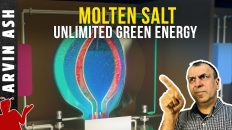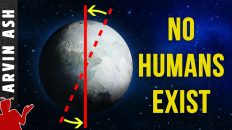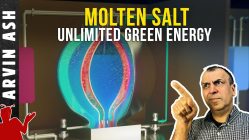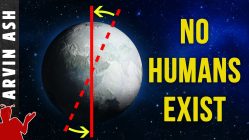Abiogenesis – origin of life. Living matter from non-living matter
If in an instant, you could magically transport yourself to the ancient earth 4.5 billion years ago. And then in the next instant you magically transported yourself to now, you may say that only magic or a supernatural force could have transformed the earth to its present day from its humble beginnings.
The diversity of life on earth today can be explained largely through evolution via natural selection – a process that occurred over billions of years. But this diversity must have had a seed of some kind. The first semblance of life, at some point, must have had a beginning, a start from the primordial soup. And it must have started from nonliving matter.
But how is it that the seemingly unremarkable processes of geology, chemistry, and physics could have combined in precisely the correct sequence, to produce the first living matter from nonliving matter.
This seems to many people utterly impossible. There must have been a blueprint. There must have been an architect. They say.
How could such vastness of diversity, functionality, and beauty come from the physical processes of the cosmos and nature? And how could it have happened on its own? That’s coming up right now.
The origin of living organisms from inorganic or non-living material is called abiogenesis. It is important to distinguish this from evolution. Abiogenesis is not evolution.
Evolution is the process of development or diversification of living things from earlier forms of living things. Evolution does not say anything about how the life first originated.
So how DID the first life originate? Despite the incredible variations of life we see today, at the fundamental level, all living things contain a trinity of elements:
Nucleic acids, which make up the DNA (or its simpler form called RNA) in your body, these contain the blueprints of life. Second, there are Proteins, which are the workhorses that perform the important functions of your body. And third are lipids which encapsulate the cells of your body.
Before any living things existed, before animals, plants and even bacteria existed, these three things had to have been present in the primordial soup in order for life to start.
Some argue that the most important component of this trinity are the lipids which make up the cell walls. Why would this be the most important?
…because without the wall or a way to encapsulate certain elements within the soup, there would just be a soup of material that would just be disorderly and floating around in a sea of liquid. It would not be functioning inside something that could potentially self-replicate.
But because these lipid membranes could potentially form around other elements, they could bring disparate parts of various chemicals together that could potentially interact, combine, react and work together to perhaps eventually form a kind of machinery for self replication.
So these fatty membranes composed of lipids were critical components for abiogenesis. So any study of abiogenesis should perhaps start with a closer examination of lipids.
Lipids molecules have a unique structure. There is a round part and a long tail part. It so happens that the round part loves water. It’s hydrophilic. The tail part however hates water. It’s hydrophobic. So what tends to happen is that when a bunch of lipids are floating around in water, they tend to gather together and self-assemble into spheres.
Why does this happen? Because the tail part of the molecule, since it wants to get away from water automatically faces other tails that also dislike water. And the round part, which likes water, exposes itself to the water outside and inside the sphere. It is what this type of molecule does naturally. So it has a tendency to self-assemble into natural spheres.
But where do Lipids come from? It was once thought that they could only be produced by living cells. But experiments have shown that when carbon monoxide and hydrogen is heated up with minerals commonly found in earth’s crust. All components were available in the early earth, and could have happened in hydrothermal vents.
You might at this point say, aha – that’s it! That’s how the first cell must have formed.
Not so fast. It turns out that lipids do have this quality of self assembly.
However, when there are certain ions present in the water such as salt or magnesium, it destroys the lipid spheres. They disintegrate. But the problem is that RNA and other functions of a cell require salts and other ions. And since the early earth was believed to have salty oceans, and since the spheres can’t form in them, this theory always had a gaping hole.
However, just this year in 2019, researchers at the University of Washington showed that lipid spheres do not disassemble if they are in the presence of amino acids, precursor to protein molecules. In addition, the enclosing of amino acids within cell walls allows the amino acids to concentrate within the walls and interact with each other to form proteins, which is part of the trinity – one of the essential components of life.
What is remarkable about this research is that it turns out that nonliving lipid cell walls and non-living proteins need each other to exist, in ion rich or salty water. Amino acids allow membranes to exist in the presence of magnesium, which RNA needs to function.
So now we see that lipids and proteins can potentially form in the presence of each other. What about DNA and RNA. These are the key self-replicating molecules, the blueprints of all living things.
Today, genetic information is stored in DNA. RNA is created from DNA to put that information into action. RNA can direct the creation of proteins and perform other essential functions of life. The simplicity of RNA compared to its cousin DNA, is the reason that most scientists think DNA came from RNA.
This is part of the “RNA world” HYPOTHESIS, which theorizes that RNA – the molecule that today plays roles in expressing genes was the essential precursor which led to the first living matter.
Only later did its more complex cousin, DNA take over the task of storing and replicating genetic information. This hypothesis has gained wide acceptance by scientists.
So let’s look at RNA. How did the first RNA molecule form from non-living chemicals?
Well, the answer to this is not as clear cut. This has been a major stumbling block to any theory of abiogenesis. So here are some theories.
RNA is made of three chemical components: the sugar ribose, the bases and phosphate. A ribose-base-phosphate unit links together with other ribose-base-phosphate units to form an RNA polymer. Figuring out how the bond between the bases and ribose first formed has been a difficult to replicate in the lab.
Attempts to show how ribose bonds can form with the bases of RNA have had been largely unsuccessful. This is because cells in our body require complex enzymes to bring RNA building blocks together before they combine to form polymers.
In a 2009 study, researchers at Rensselaer Polytechnic Institute, in Troy, NY showed that current day RNA could have formed on the surface of clays which act like catalysts to bring RNA bases together as shown in this animation.
A 2017 paper by scientists from McMaster University in Canada, and the Max Planck institute in Germany showed that the building block of RNA could have polymerized in the early earth using organic molecules from meteorites and interplantary dust in shallow ponds. The wet-dry cycle of these ponds, they showed are conducive to RNA polymerization. They also theorize that such polymers were probably present on earth shortly after its formation as early as 4.17 billion years ago.
So now we have ways that 2 of the trinity could have formed, RNA and lipids. But what about proteins? How did they form?
In the 1950s, several experiments by Stanley Miller and Harold Urey verified that the natural formation of amino acids, components of proteins, and other organic compounds out of inorganic materials was possible under the atmospheric conditions of Primordial Earth.
So the precursors of proteins were likely present in the very early earth.
It turns out that it’s pretty easy to form many kinds of organic molecules, in a wide range of environments. But so far, I have only presented ways that can result in potential precursors of the trinity or three elements needed for life.
You might say, well that’s fine and dandy, but having all the precursors get together inside a lipid cell wall does not necessarily mean that they will all come together to form a self-replicating living cell. So how the heck do you explain that Mr. Scientist? How do complex molecules come together to self-replicate and become a living organism?
And if I am being honest, this is currently not well understood, and there is no experiment or smoking gun evidence that points to a precise mechanism of how this happened.
There are creationist arguments such as the one that says, if I put all the parts of a watch in a big vat and keep stirring it a million years, a functioning, ticking watch is not going to magically form inside the vat.
And some cite an estimate by scientists Fred Hoyle and Chandra Wickramasinghe showing that the probability of all the chemicals in a simple bacterium arising on their own by chance, is something on the order of one in ten to the 40,000th power, which more than the Planck volume of the entire universe.
But this and the clock parts-in-a-vat arguments are oversimplifications. They ignore the fact that sophisticated life forms like current day bacteria almost certainly did not arise spontaneously, but arose in much simpler incremental steps.
There are stats such as the one that says the odds of creating a protein molecule by chance is 1 in 10^45 power. Odds such as these and others not only ignore the idea of simpler precursors, but also ignore the fact that it was not just one set of amino acids at one place, at one time, but it was trillions upon trillions of amino acids reacting in countless places, over millions of years that resulted in simple protein molecules. There are about 4×10^47 molecules of water in earth’s oceans. Even if there was one amino acid among one million water molecules, that is 10^41 molecules of amino acids that had the opportunity to interact with each other to form proteins in numerous environments, in numerous trials over millions of years to produce proteins.
The actual probability is not how the hundreds of complex chemicals can come together to form a modern day bacterium, but the probability of a few chemicals forming and coming together to form the precursors of life that can chemically evolve over time to form the simplest kind of life form that likely looked nothing like any evolved life form we recognize today.
But showing how even this chemical evolution could have happened is problematic. Chemical evolution is not the same as biological evolution which is driven by favoring organisms that have the best chance of survival and reproduction.
Scientists have had trouble figuring out what could have driven chemicals to evolve the complexity needed for biological functioning.
But in 2014, Jeremy England, physics professor at MIT showed mathematically that the driving force for chemical evolution may be hidden in physics – in Newton’s second law of thermodynamics.
Entropy. From a physics point of view, the one thing that distinguishes living things from non-living things is its ability to capture energy and convert it to heat.
England argues that when exposed to an external source of energy, such as the sun, any group of molecules will restructure themselves to dissipate more and more energy. This he says is the driving force for chemical evolution. And this can, over time result in living organisms such as those we see today. Organisms that are super efficient at dissipating energy.
In addition, Karo Michaelian, from the Department of Physics at UNAM, in Mexico showed in a 2011 paper that “RNA and DNA are the most efficient of all known molecules for absorbing the intense ultraviolet light that penetrated the dense early atmosphere”
While there is no single generally accepted theory for the origin of life, all credible proposals show that life under natural conditions by a slow processes of chemical and molecular evolution could plausibly result in simple life forms over a long period of time.
And that this evolution of chemistry probably was the biggest hill to climb for life to have occurred on earth.
But once this happens, biological evolution takes over, and relatively quickly can result in exceptional diversity of life forms. We see that in the fossil record of early earth, and of course we see that on the earth of today.
Do we have proof that this is how life came about – no. At least not yet. Is it plausible – absolutely. Just like chemical and biological evolution, our knowledge too is evolving in a slow process over hundreds and thousands of years driven by the pursuit of science, and hopefully ever decreasing ignorance.
If you want to support us and see more videos like this then, please subscribe, and give us a like. I’ll see you in the next video.








[…] Ash also agrees, as he says in the first three in his twelve-minute film presentation, Abiogenesis – How Life Came from Inanimate Matter,” (Sept 7, 2019). And the Wikipedia article on Abiogenesis concurs as […]